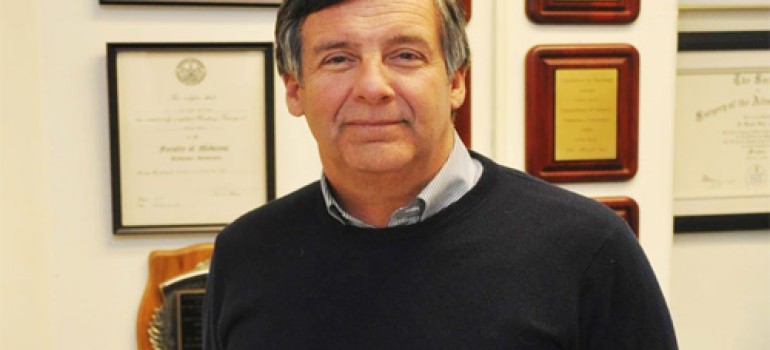
Levelling up; what medical students really need to know to succeed
Each May, the graduating class of Dalhousie Medical School awards one of their professors the Silver Shovel Award. It’s an honour that recognizes teaching excellence, rewarding a professor’s dedication, compassion and commitment to helping their students succeed. Dr. Brock Vair has won the Silver Shovel three times, taking home the award in 1997, 2011 and 2013. Here, he shares his insights on changes in medical education, the importance of communication and what medical students really need to know to succeed.
Early lessons
You could say that Dr. Vair’s teacher training began when he was still in medical school. Dr. Vair – who is now a professor of surgery and the director of education within the Department of Surgery at Dalhousie University – graduated from Dalhousie Medical School in 1976, going on to complete his residency in general surgery at Dalhousie University and a clinical and research fellowship at the University of Florida.
He credits three physicians from his formative years with influencing his educational style: Dr. Murray Nixon, a family doctor in Halifax; Dr. Mohan Iype, a surgeon in Saint John, N.B.; and Dr. Audley Bodurtha, a surgeon in Halifax.
“The way that they dedicated themselves to teaching was inspiring,” says Dr. Vair. “They broke their presentations down into building blocks and encouraged us to work through illustrative cases. It was an easy way to learn and something I chose to emulate in my own teaching.”
When it comes to the lecture hall, Dr. Vair isn’t one to turn off the lights and show slides while talking for an hour. Instead, he asks his students to work through representative case presentations.
“I don’t tell them what to think,” he says. “I ask them, ‘What’s the best next step? What questions should we be asking?’ They might guess wrong, or suggest an inappropriate option, but that just presents another learning opportunity.”
That attitude – treating even wrong answers as a learning opportunity, rather than a reason to ridicule or berate a student – is just one of the ways that Dr. Vair has seen medical education change in the nearly 40 years since his graduation. It’s not just the tone of instruction that is different; the topics are, too.
“The volume of material that students are expected to know has increased dramatically,” says Dr. Vair. “And it’s not just medical knowledge. Now, students are also learning communication skills, professional competencies and business knowledge.”
That means that when today’s students graduate, in addition to having excellent medical skills, they’ll also know how to communicate effectively with their colleagues, how to break bad news to a patient or calm a concerned parent, and the ins and outs of setting up and running their own business – skills that Dr. Vair had to learn on the job.
Communication is key
“One of the best things I ever did for my clinical practice and my teaching career was to get involved with the communication skills program,” says Dr. Vair.
The program starts at the very beginning of medical school, when brand-new medical students gather in small seminar groups and are introduced to the basics of communication. While the initial conversations can get personal in a hurry, Dr. Vair says that it’s all good experience.
“Research shows that in the typical doctor-patient interaction, it’s just 15 seconds before the doctor interrupts the patient,” he says. “The communication skills training teaches our students to be comfortable with being patient; that it’s worth waiting for a reply. Your patient will tell you what you need to know – if you can take the time to listen for the answer.”
A new frontier
The emphasis on communication skills isn’t limited to the halls of Dalhousie. In his work with the Skills and Simulation Centre (a project with Dalhousie, the IWK and the QEII), Dr. Vair helps medical learners develop both technical and interpersonal skills.
It’s another example of how medical education has changed since Dr. Vair graduated.
“I placed my first chest tube in a live patient,” he says – making a high-pressure situation even more challenging. “At the simulation centre, students can use simulation models and cadavers to practice potentially injurious skills in a safe environment.”
The program helps young physicians develop their communication and collaboration skills, and also bolsters inter-professional collaboration by allowing doctors the opportunity to train alongside registered nurses and paramedics.
“Medical simulation is a new frontier in medical education,” says Dr. Vair, who says that as the program continues to grow, it will continue to benefit health professionals and the people they care for. Whether it’s practising technical skills or developing strong teams, “ultimately, it all translates into better patient care,” he says.
Levelling up
When he’s teaching, Dr. Vair has one eye on the present needs of his students, and the other on the long-term – balancing what they need to know now with what they will need to know down the road.
“I try to set aside the minutiae,” says Dr. Vair. “I try to define the things that are important for them to know in each disease process or presentation, in a way that’s appropriate for their knowledge level.”
“I focus on teaching my students the essentials for where they are in the current stage of their education. It’s about assessing their current level of knowledge and what that knowledge level should be, and then figuring out how to fill the gap.”
Dr. Vair finds that filling those gaps – and working with his students through successive levels of their education – intensely rewarding.
“Bringing a student through medical school to residency, seeing them succeed and mature as a learner and then as a physician, is one of the most gratifying parts of my work,” he says.
With three Silver Shovels to his name, it’s easy to see that his students appreciate his efforts.
This story originally appeared in the September 2015 issue of doctorsNS magazine.
